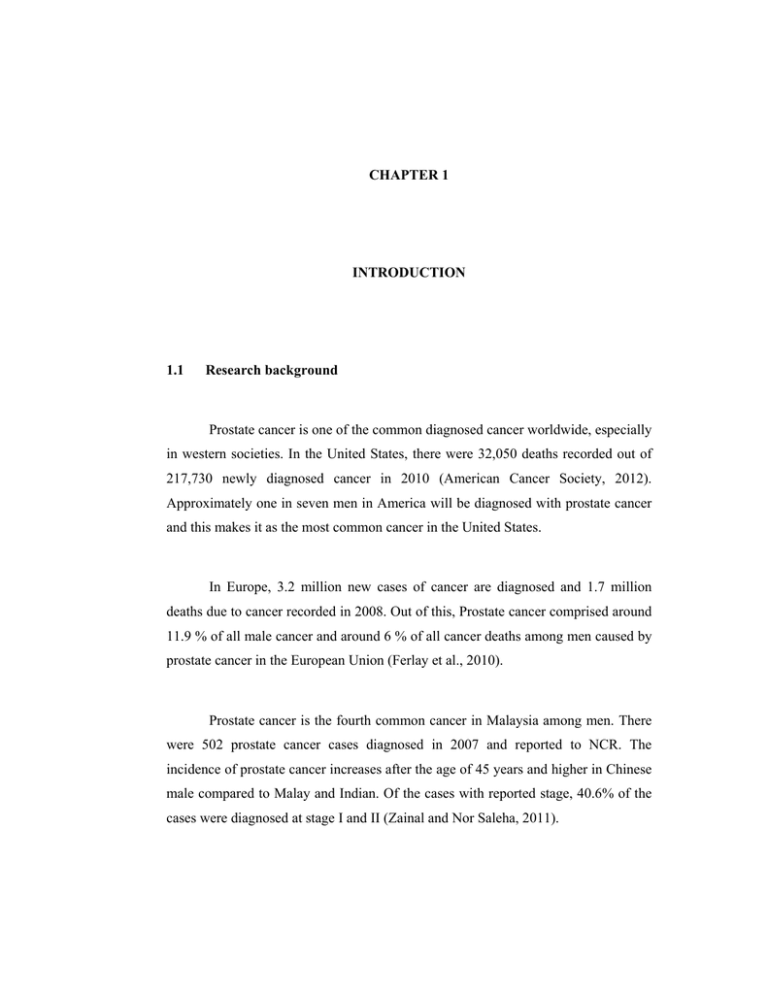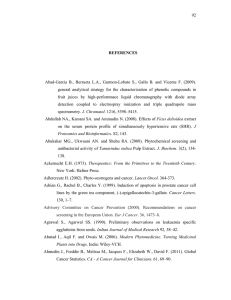CHAPTER 1 INTRODUCTION 1.1 Research background
advertisement

CHAPTER 1 INTRODUCTION 1.1 Research background Prostate cancer is one of the common diagnosed cancer worldwide, especially in western societies. In the United States, there were 32,050 deaths recorded out of 217,730 newly diagnosed cancer in 2010 (American Cancer Society, 2012). Approximately one in seven men in America will be diagnosed with prostate cancer and this makes it as the most common cancer in the United States. In Europe, 3.2 million new cases of cancer are diagnosed and 1.7 million deaths due to cancer recorded in 2008. Out of this, Prostate cancer comprised around 11.9 % of all male cancer and around 6 % of all cancer deaths among men caused by prostate cancer in the European Union (Ferlay et al., 2010). Prostate cancer is the fourth common cancer in Malaysia among men. There were 502 prostate cancer cases diagnosed in 2007 and reported to NCR. The incidence of prostate cancer increases after the age of 45 years and higher in Chinese male compared to Malay and Indian. Of the cases with reported stage, 40.6% of the cases were diagnosed at stage I and II (Zainal and Nor Saleha, 2011). 2 According to GLOBOCAN 2008; (a project of the International Agency for Research on Cancer), Prostate cancer was the second most diagnosed cancer among male, the 5th common cancer overall, and the 6th cause of death in men from cancer worldwide. Recently, GLOBOCAN announced that around 258,000 patients died due to prostate cancer in 2008, with an estimated 899 000 new cases (Ferlay et al., 2010). Novel anticancer agents are needed because many cancer patients developed resistance to standard anticancer agents during treatment. In addition, these agents are toxic causing undesired side effect and also hypersensitive reactions. Presently, less than 1% of the estimated 250000 higher plant species on earth has been investigated chemically for their bioactivity. There are still possibilities of finding novel compounds with desired bioactivity (Nor Azurah, 2011). Several species of Fig tree showed to have multiple cancer preventive, antiinflammatory and cancer therapeutic effects. Ficus deltoidea is one of these species of Fig trees “or as locally known as Mas Cotek” from the family Moraceae. Recently this herb attracts many researchers who are interested in traditional medicine and phytotherapy. Its therapeutic effect includes regulating blood circulation, and also traditionally its leaf is used by female as post partum medication. Compared to other traditional Malaysian herbs, this plant species receives little scientific research and the information regarding is very limited. Studies have shown that Labisia pumila plant extract contains certain phytochemicals which have great potential in cancer prevention specifically prostate cancer. Flavonoids and other phenolic acids are compounds that are found in the plant extract in remarkable amount are responsible for the wide spectrum of pharmacological activities attributed to the herb (Zhang et al., 2008). Even though, no specific research has been done to investigate the anticancer properties of Labisia pumila extract, the presence of these phytochemicals could lead to the finding of another great potential of the plant. Other researches using plant extract with similar phytochemical compounds have clearly displayed their anticancer properties by 3 addressing some of the hallmarks of cancer. Gallic acid is identified as the major anticancer compound in T.sinesis leaf extract. Studies done using this extract showed that gallic acid is cytotoxic to DU145 prostate cancer cells through generation of reactive oxygen species (ROS) (Huei et al., 2009). Cell based assay is increasingly used in the recent years for determination of bioactivity of plant extracts. Simplicity of homogenous methods and correlation with in vitro cytotoxicity data made this assay as an alternative method for animal testing in toxicology laboratories. Cell culture technology enables us to investigate the effect of plant extract on cell viability or cytotoxicity in vitro and also observation of cell morphology (Freshney, 2005). There are several ways to determine cell viability and observation of cell morphology. Staining and observation of cell morphology under light or fluorescence microscope is one of these methods and molecular method is another one by using DNA fragmentation screening we can distinguish between the cells. MTT assay is a standard colorimetric method that can be used for determining the biochemical activity of the extracts by distinguishing between the live and dead cells and when there was any disruption of critical biochemical function (Lobnar, 2000). 1.2 Objective of study The objective of this study is to establish the effect of aqueous extract of Ficus deltoidea and Labisia pumila on the growth and survival of prostate carcinoma cell line (DU145). 4 1.3 Scopes of the study The scopes of this study are: 1. To investigate the effect of Ficus deltoidea aqueous extracts on the characteristics and the morphology of human prostate carcinoma cell line. 2. To investigate the effect of Labisia pumila aqueous extracts on the characteristics and the morphology of human prostate carcinoma cell line. 3. To compare the effect of Ficus deltoedia aqueous extract with the effect of Labisia pumila aqueous extract on the Human Prostate carcinoma cell line. 1.4 Research contributions This research contributed in the finding the importance of Ficus deltoidea and Labisia pumila extracts as a medicinal and anticancer agents against prostate cancer. This study maybe counted as the basic steps in finding novel drugs for prostate cancer cell, which will pave a way for future studies especially in mechanism of action of these extracts and isolating the active phytochemical compounds in the extracts in order to treat this disease at its early stages.






